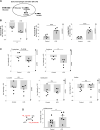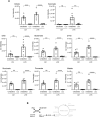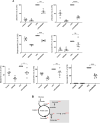BCAT1 affects mitochondrial metabolism independently of leucine transamination in activated human macrophages
- PMID: 33148611
- PMCID: PMC7116427
- DOI: 10.1242/jcs.247957
BCAT1 affects mitochondrial metabolism independently of leucine transamination in activated human macrophages
Abstract
In response to environmental stimuli, macrophages change their nutrient consumption and undergo an early metabolic adaptation that progressively shapes their polarization state. During the transient, early phase of pro-inflammatory macrophage activation, an increase in tricarboxylic acid (TCA) cycle activity has been reported, but the relative contribution of branched-chain amino acid (BCAA) leucine remains to be determined. Here, we show that glucose but not glutamine is a major contributor of the increase in TCA cycle metabolites during early macrophage activation in humans. We then show that, although uptake of BCAAs is not altered, their transamination by BCAT1 is increased following 8 h lipopolysaccharide (LPS) stimulation. Of note, leucine is not metabolized to integrate into the TCA cycle in basal or stimulated human macrophages. Surprisingly, the pharmacological inhibition of BCAT1 reduced glucose-derived itaconate, α-ketoglutarate and 2-hydroxyglutarate levels without affecting succinate and citrate levels, indicating a partial inhibition of the TCA cycle. This indirect effect is associated with NRF2 (also known as NFE2L2) activation and anti-oxidant responses. These results suggest a moonlighting role of BCAT1 through redox-mediated control of mitochondrial function during early macrophage activation.
Keywords: BCAT1; Immunometabolism; Macrophages; Mitochondria; Redox biology; TCA cycle.
© 2020. Published by The Company of Biologists Ltd.
Conflict of interest statement
Competing interestsA.E.P. is an employee of Ergon Pharmaceuticals Ltd. The remaining authors declare no competing financial interests.
Figures





References
-
- Bambouskova M., Gorvel L., Lampropoulou V., Sergushichev A., Loginicheva E., Johnson K., Korenfeld D., Mathyer M. E., Kim H., Huang L.-H. et al. (2018). Electrophilic properties of itaconate and derivatives regulate the IκBζ-ATF3 inflammatory axis. Nature 556, 501-504. 10.1038/s41586-018-0052-z - DOI - PMC - PubMed
-
- Bulua A. C., Simon A., Maddipati R., Pelletier M., Park H., Kim K.-Y., Sack M. N., Kastner D. L. and Siegel R. M. (2011). Mitochondrial reactive oxygen species promote production of proinflammatory cytokines and are elevated in TNFR1-associated periodic syndrome (TRAPS). J. Exp. Med. 208, 519-533. 10.1084/jem.20102049 - DOI - PMC - PubMed
-
- Cameron A. M., Castoldi A., Sanin D. E., Flachsmann L. J., Field C. S., Puleston D. J., Kyle R. L., Patterson A. E., Hässler F., Buescher J. M. et al. (2019). Inflammatory macrophage dependence on NAD+ salvage is a consequence of reactive oxygen species-mediated DNA damage. Nat. Immunol. 20, 420-432. 10.1038/s41590-019-0336-y - DOI - PubMed
Publication types
MeSH terms
Substances
Grants and funding
LinkOut - more resources
Full Text Sources
Molecular Biology Databases

